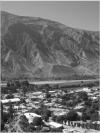Resumen
El impacto producido por el ferrocarril en el territorio argentino no ha tenido similitudes en la historia, ni antes ni después.El modelo de ocupación implicó un nuevo ordenamiento territorial basado en la inserción de una red con fines económicosextractivos.Este trabajo responde a un análisis del poblamiento surgido como consecuencia de la instalación del ferrocarrilen el Noroeste argentino, la estructura urbana que han tenido los nuevos pueblos y las transformaciones producidas en lospoblados y ciudades preexistentes. El sistema de asentamientos se explica a partir del fenómeno urbano que comprende dosaspectos: la forma –referido a la morfología de la trama– y la función –relacionada con las actividades que mayoritariamentedesarrollaron los pueblos que nacieron como producto de una red ferroviaria–. Como resultados se obtuvieron los elementoscomponentes del sistema de asentamientos empleado como modelo. La investigación se basó en los trabajos de campo realizadosen más de 200 estaciones de ferrocarril de la región del Noroeste argentino integrada por las provincias de Tucumán,Salta, Jujuy, Santiago del Estero y Catamarca. Se ha trabajado además con diferentes fuentes documentales como planimetríacensal, fotografía satelital, legislaciones provinciales, así como cartografía actual y de fines del siglo xix.La revista Apuntes se encuentra registrada bajo la licencia Creative Commons Reconocimiento 4.0 Internacional. Por lo tanto, esta obra se puede reproducir, distribuir y comunicar públicamente en formato digital, siempre que se reconozca el nombre de los autores y a la Pontificia Universidad Javeriana. Se permite citar, adaptar, transformar, autoarchivar, republicar y crear a partir del material, para cualquier finalidad (incluso comercial), siempre que se reconozca adecuadamente la autoría, se proporcione un enlace a la obra original y se indique si se han realizado cambios. La Pontificia Universidad Javeriana no retiene los derechos sobre las obras publicadas y los contenidos son responsabilidad exclusiva de los autores, quienes conservan sus derechos morales, intelectuales, de privacidad y publicidad.
El aval sobre la intervención de la obra (revisión, corrección de estilo, traducción, diagramación) y su posterior divulgación se otorga mediante una licencia de uso y no a través de una cesión de derechos, lo que representa que la revista y la Pontificia Universidad Javeriana se eximen de cualquier responsabilidad que se pueda derivar de una mala práctica ética por parte de los autores. En consecuencia de la protección brindada por la licencia de uso, la revista no se encuentra en la obligación de publicar retractaciones o modificar la información ya publicada, a no ser que la errata surja del proceso de gestión editorial. La publicación de contenidos en esta revista no representa regalías para los contribuyentes.


